
To find the LU decomposition of Matrix A given as:
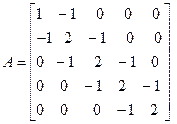
Explanation of Solution
LU Decomposition of A: The LU Decomposition of A means to decompose a matrix A into a product of lower triangular matrix and upper triangular matrix.
In Decomposition of A the input is lower triangular matrix and output is upper triangular matrix obtain by applying following row operation on A.

Here,

and

And lower triangular matrix is given by

Consider a matrix,

Initially calculate the value of all entries other than 0 and 1 of equation (1).
Apply the row operation to the matrix A to find the upper triangular matrix U
Calculate the value of 
 (2)
(2)
Calculate the value of  ,
,
 (3)
(3)
Calculate the value of 
 (4)
(4)
Calculate the value of 
 (5)
(5)
Apply row transformation  to find upper triangular matrix.
to find upper triangular matrix.
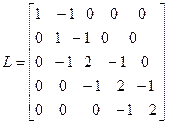
Similarly calculate the value of,
 …… (6)
…… (6)
Calculate the value of,
 …… (7)
…… (7)
 …… (8)
…… (8)
Apply row transformation  to find upper triangular matrix.
to find upper triangular matrix.
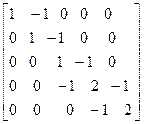
Calculate the value of,
 (9)
(9)
Calculate the value of,
 (10)
(10)
Apply row transformation  to find upper triangular matrix.
to find upper triangular matrix.
The upper triangular matrix is-
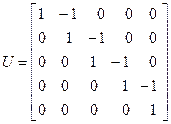
The lower triangular matrix is-

Hence, the LU decomposition of A is-

To solve the equation  by using forward and backward substitution.
by using forward and backward substitution.
Explanation of Solution
Consider an expression-


To solve this, the following steps are followed-
Express  in the
in the  decomposition form-
decomposition form-
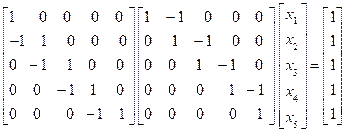
Let for any
• LUP Decomposition
• Forward Substitution
Let 
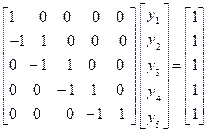
After solving, the following value of  is obtained-
is obtained-

• Backward Substitution

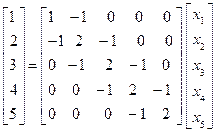
Solving for 

To find the inverse of A.
Explanation of Solution
Inverse of a matrix  is a matrix
is a matrix  such that
such that  where
where  is an identity matrix.
is an identity matrix.
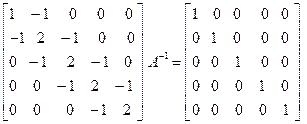
To solve this, the following steps are followed-
• Forward Substitution
Let 
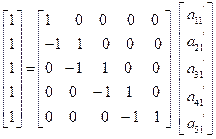
After solving, the following value of  is obtained-
is obtained-

Similarly, other columns can also be obtained in the following way-



Inverse of the matrix can be formed by using the five results which comprises the columns of the inverse matrix.

• Backward Substitution
Now find  from
from 
Solving for 

To show how, for any  symmetric positive-definite, tridiagonal matrix
symmetric positive-definite, tridiagonal matrix  and any n-vector
and any n-vector  to solve the equation
to solve the equation
Explanation of Solution
Inverse of a matrix  is a matrix
is a matrix  such that
such that  where
where  is an identity matrix.
is an identity matrix.

To solve this, the following steps are followed-
• Forward Substitution
Let 
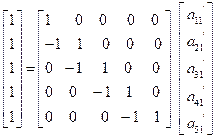
After solving, the following value of  is obtained-
is obtained-

Similarly, other columns can also be obtained in the following way-



Inverse of the matrix can be formed by using the five results which comprises the columns of the inverse matrix.
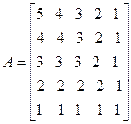
• Backward Substitution
Now find  from
from 
Solving for 

To show that, for any  non-singular, tridiagonal matrix.
non-singular, tridiagonal matrix.
Explanation of Solution
Forward and Backward substitution take the same amount of operations as in the previous case. The only different case is the decomposition step. In this case, the decomposition is done into unit lower triangular and upper triangular matrix, and. The pivoting is done by the swapping rows such that the highest element of a column comes to the diagonal place. The decomposition looks like the following:

Here,  loses the tri-diagonal property of matrix
loses the tri-diagonal property of matrix but it is still a banded matrix. The essence to solve this is similar to the tri-diagonal case. The time complexity now depends on the width of the band or the distance between the farthest diagonals of the resultant matrix. Matrix becomes wider than the upper triangle of the initial matrix. The final complexity becomes
but it is still a banded matrix. The essence to solve this is similar to the tri-diagonal case. The time complexity now depends on the width of the band or the distance between the farthest diagonals of the resultant matrix. Matrix becomes wider than the upper triangle of the initial matrix. The final complexity becomes
Hence the time complexity of LUP decomposition 
Want to see more full solutions like this?
- (Conversion) An object’s polar moment of inertia, J, represents its resistance to twisting. For a cylinder, this moment of inertia is given by this formula: J=mr2/2+m( l 2 +3r 2 )/12misthecylindersmass( kg).listhecylinderslength(m).risthecylindersradius(m). Using this formula, determine the units for the cylinder’s polar moment of inertia.arrow_forwardDetermine the fractal that arises from using Newton's method to compute the fixed-point solutions of the Lorenz equations. Matlab codearrow_forwardGiven A = {1,2,3} and B={u,v}, determine. a. A X B b. B X Barrow_forward
 Operations Research : Applications and AlgorithmsComputer ScienceISBN:9780534380588Author:Wayne L. WinstonPublisher:Brooks Cole
Operations Research : Applications and AlgorithmsComputer ScienceISBN:9780534380588Author:Wayne L. WinstonPublisher:Brooks Cole C++ for Engineers and ScientistsComputer ScienceISBN:9781133187844Author:Bronson, Gary J.Publisher:Course Technology Ptr
C++ for Engineers and ScientistsComputer ScienceISBN:9781133187844Author:Bronson, Gary J.Publisher:Course Technology Ptr

